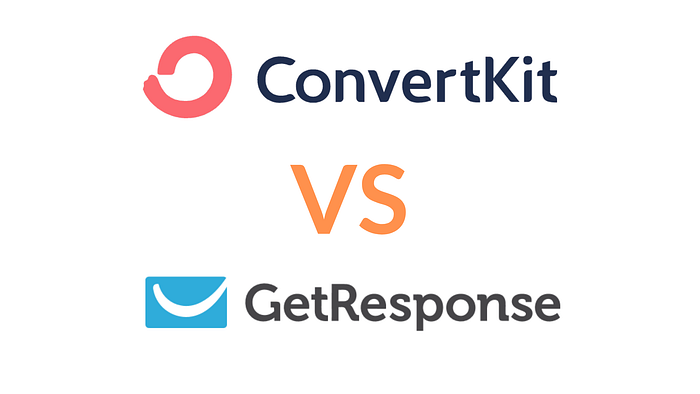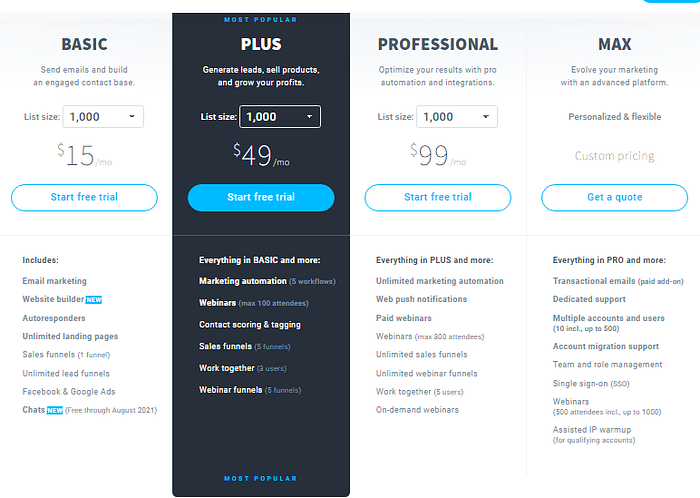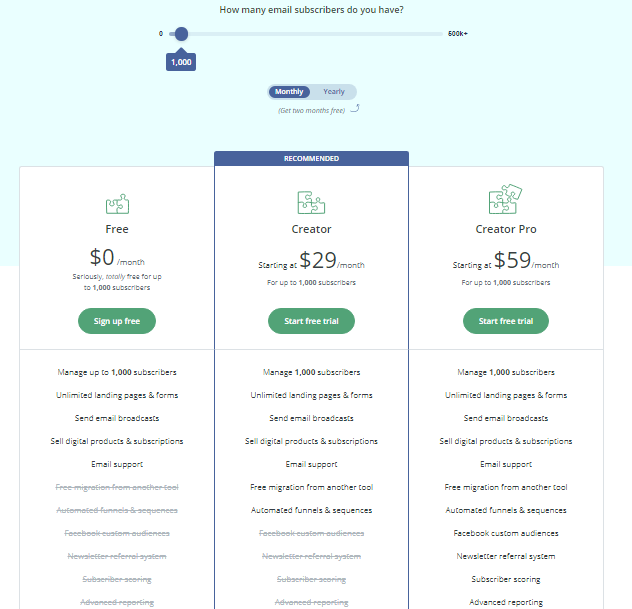GetResponse vs ConvertKit (2021) Which is Best? The Ultimate Guide
Personally, in most cases, I tend to use GetResponse, because a slightly higher learning curve can be rewarded by extending the functionality. If you only have a blog and want something suitable for storytelling and personal branding, ConvertKit is a good choice (although more expensive).
This post contains affiliate links, if you register through our link, we may get a small commission with no additional cost to you.

When you research a large number of email marketing solutions for your business, it’s easy to be vague and lean towards the cheapest option, after all, about 85% of people use the same keywords to attract you. This shows that they are mostly a large number. So, if they are almost the same, why not look for the cheapest automation solution?
I saw how it happened. This is a completely effective method. However, we are here to try to help the autoresponder adjust these tools to the most suitable tools for your business, which may not be as simple as the cheapest ones.
Main Differences Between GetResponse vs ConvertKit
- GetResponse provides dedicated webinar automated auto-response workflow builders, while ConvertKit does not.
- GetResponse is very suitable for marketers, and ConvertKit is more suitable for the subscription.
GetResponse:
GetResponse has always existed. Well, since 1998, but in terms of technology, mergers and acquisitions have occurred on the left, right, and center. I believe 19 years are eternal.

In fact, other than that, there is not much information about the company. Their year of establishment shows that they are one of the first companies to find a commercially viable way to help people really do email marketing. I think in this regard, they are the first to realize that there is some way to do this.
GetResponse has some different elements, such as webinars, landing page creation, and marketing automation, but its core function is still mainly email marketing tools.
Features:
In fact, there is nothing to say about the entry-level features of GetResponse. It is indeed the most basic email marketing function and some basic marketing automation. This is not groundbreaking, but it will definitely make you scroll.
I always find it strange to talk about the GetResponse webinar feature, which is one of the features introduced in its second level. I always feel that marketers who need this will operate in that niche market. If they are promoting a product that may require explanation or some kind of educational service, this may help.
Either way, when you enter the second level of GetResponse, you can host a webinar with up to 100 people. Other additional features at this level include your automated triggers, such as emails sent when someone abandons your shopping cart on your e-commerce website, and event tracking from the web, which is very important for page builders when creating pages. it works.
When you reach the third level, GetResponse starts to feel a bit like an agency rather than a digital marketing tool, mainly because the package includes event consulting. This is a relatively common feature of the higher SaaS layer, and the supplier will assign you a real person to work with to ensure the success of your event.
This level also includes integration with Salesforce CRM. I like this: I really like the things that I wear in combination with other things I wear. What is unclear is whether it can be integrated with other software packages.
The top-level becomes a complete agency, equipped with a dedicated account manager for you.
User Interface & Usability:
GetResponse seems to position itself as a CRM platform, not just an email marketing platform. This has some advantages and disadvantages.
For newbies in email marketing, this can be a bit scary. I am grateful if all you want to do is to make your email marketing campaign go smoothly.
On the other hand, if you know something about CRM and its functions, but you know that you don’t need a complete CRM, then GetResponse may be a suitable alternative to act as a “lightweight CRM.” It feels that they have removed most of the functions of CRM and focus on its e-mail sending function.
Once you log in to GetReponse, it will start asking for your contact list. I mean, I know this is very comprehensive for what it is supposed to do, but it seems necessary: we have received enough privacy warnings throughout the entire Internet usage process, and I feel that before starting to distribute my contact information, I want to build my trust a little bit more. I am sure it is completely harmless. But still…
I think one thing that makes GetResponse attractive to newcomers is that they provide free consultation sessions for new users. I think it’s great to have it, especially for those who are completely unfamiliar with email marketing tools and can use some initial positioning.
Pricing:
As the standard for such digital marketing automation tools, GetResponse has a tiered pricing system, and the price changes according to your needs. The main variables are the number of features you want and the number of people you need to contact.
Let’s start with the most basic package. If you want to communicate with up to 1,000 people, it will cost you $15 per month. If you are not familiar with email marketing, this is not a bad starter package, it will definitely get you started right away.

However, it is a basic package, so its functionality depends largely on these emails. But when you deal with something like this for the first time, I think it’s best to take a moment to hold onto a project and then hand over more cash for something that sounds great in the sales promotion. But I don’t fully understand.
Although the basic package relies heavily on email, you do get some marketing automation features and landing page templates for marketing campaigns and registration forms-enough to get you started.
As your business expands, you can keep this basic package and its features for up to 100,000 subscribers to start using your automation tools. If you stay that far, it will cost you $450 per month. Frankly speaking, if you have 100,000 subscribers, you will look for updates to find the most effective way to manage all subscribers.
It should also be noted that GetResponse provides discounts for users who can pay for one year of service at a time and additional discounts for users who can pay for two years of service.
ConvertKit:
ConvertKit was only released in 2015, but don’t be delayed because they are basically still in their infancy. They have been working hard, and two years later, they now have 24 employees in 17 countries.

In addition, ConvertKit seems to have its story close to its chest. The founder of the company Nathan Barry has a blog that discusses how to develop it, but nothing more.
So how can a baby company like ConvertKit stand out among many companies that provide similar services?
Well, they can do this in many ways, including what they usually claim to be better, cheaper, and easier to use, but the approach they take is to focus on providing a group of people with truly good services. The niche audience they choose to do is professional bloggers.
Features:
Due to its focus on niche markets like bloggers, ConvertKit is very smart and has developed a plugin for WordPress. WordPress is one of the leading blogging platforms, and its ability to customize things without coding knowledge through plugins is one of the main reasons why it is so popular.
It says that ConvertKit understands its audience, and they would rather spend time writing than deciphering the code.
ConvertKit has many “if this, then that” methods for its functions. I say this because its main function seems to rely on the email drip irrigation sequence, and depending on the action they take on your activity, whether they are buying an item or abandoning the shopping cart, they will send an appropriate email to someone. Or just view the campaign page.
It has an opt-in form feature that I really like (also: dual opt-in form). This is a convenient way to have a dedicated, clear-looking landing page, and it’s not a headache, and it’s inherently connected to your email marketing efforts.
I am a big fan of data analysis, and I know as much of the audience as I can. For me, this is where ConvertKit fell. When you log in, you will see a graph showing your subscription performance and some information about your subscription, but nothing more.
If you are also obsessed with data, you may also be disappointed. You can use Google Analytics and your custom campaign URL builder to help, but I usually use it in conjunction with available data from email providers.
User Interface & Usability:
Using ConvertKit specifically for bloggers, you can ensure that using it will become a breeze and avoid remote technologies like the plague. That will definitely make your blogger happy! The most coding you need to do is to modify the HTML code to optimize the layout of the email.
There is nothing more to say about it. Due to its anti-technical nature, I would say that it is one of the simplest solutions imaginable, thanks in large part to its WordPress plugin. The navigation menu is clear at a glance and it is easy to grasp the direction, even if you have never learned about email marketing packages in depth before.
In addition to GetResponse, they also improved the capabilities of the customer service team. They provide regular training courses to help you make the most of your package. If you have more than 5,000 subscribers, they have a dedicated team to help you support the transition from other tools. I have seen the trouble that you can cause if you start email marketing with the wrong solution, and I know this is a great service.
If you don’t fully understand the terms related to CRM, it may be a bit tricky when trying to integrate them. It’s hard to make mistakes, but I recommend having someone on hand who knows what you integrate it with.
Pricing:
Like GetResponse, ConvertKit also has a free version. For the cost of a month of service that may not be suitable for your business, it is worth spending a little money now, instead of sticking to it just because it provides a little service for free, which will cause pain and suffering. When you don’t do what you need to do, you enter the future.

In any case, ConvertKit has three general levels. Each layer provides exactly the same set of features, and the price increase depends entirely on the number of subscribers you want to reach. This is how it breaks down.
- Up to 1,000 subscribers — — — — — — — — $29 per month
- Up to 3,000 subscribers — — — — — — — — $49 per month
- Up to 5,000 subscribers — — — — — — — — $79 per month
Which Marketing Solution is Best: ConvertKit vs GetResponse
The main question to consider when comparing these two marketing automation platform solutions is which one is more suitable for your business.
GetResponse is an ideal choice for marketers because it runs as a lightweight CRM with advanced segmentation. It has some CRM feel that appeals to marketers, but it removes many common CRM contents into email tools.
ConvertKit is a great tool for content creators to subscribe to professional blog subscriptions. It is very easy to use and you will immediately contact your readers directly.
If you’re still not sure, both solutions offer free trial periods. Sign up for each of them and see which one you think best suits your business goals.







Comments